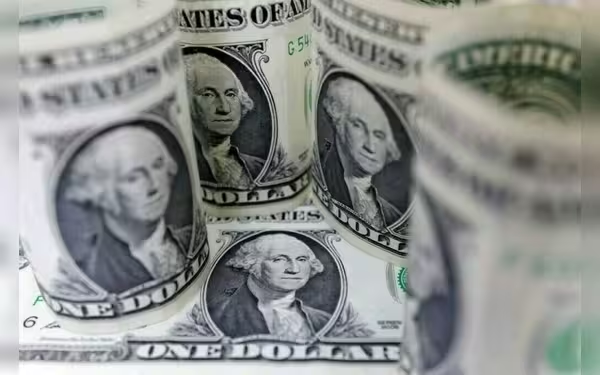Saturday, November 16, 2024 07:38 PM
Dollar Declines as Fed Rate Cut Bets Increase
- US dollar declines after two-month highs.
- Labor market weakness strengthens Fed cut arguments.
- CPI data complicates inflation control efforts.
 Image Credits: brecorder
Image Credits: brecorderThe US dollar faces decline as labor market weakness fuels bets on Federal Reserve rate cuts.
The US dollar has recently experienced a notable decline after reaching two-month highs against its major counterparts. This shift comes in the wake of emerging signs of weakness in the labor market, which have strengthened the argument for quicker rate cuts by the Federal Reserve. Despite this downturn, the dollar is still on track for a second consecutive weekly gain, following unexpectedly strong monthly payroll figures that led traders to reconsider their bets on a significant rate cut at the Fed's upcoming policy meeting.
On Thursday, the market reacted to a surge in initial jobless claims, which was further complicated by an increase in the consumer price index (CPI) reported the same day. This situation serves as a reminder that a restrictive monetary policy may still be necessary to control inflation. According to the CME Group's FedWatch Tool, the likelihood of a quarter-point rate cut on November 7 has risen to 83.3%, up from 80.3% the previous day. Just a week ago, the chances of a half-point reduction stood at 32.1%, with a 67.9% probability for a quarter-point cut.
The yield on the two-year US Treasury note, which generally aligns with interest rate expectations, fell to 3.9531% early on Friday, contributing to the pressure on the dollar. The dollar index, which gauges the currency against six peers, remained flat at 102.84 as of 0111 GMT, marking a 0.3% decline from Thursday's peak of 103.17, the highest level since August 15. For the week, the index is poised for a 0.39% increase, building on the previous week's impressive 2.06% surge.
While the Federal Reserve has indicated a shift in focus towards achieving full employment rather than solely prioritizing price stability, investors have been keenly awaiting the CPI data for signs that inflation is being managed effectively. Tapas Strickland, head of market economics at National Australia Bank, noted, "The net impact was some volatility in global markets, but on net, yields are not greatly changed." He further emphasized that the CPI results do not alter the narrative of moderating inflation, suggesting that the Fed will continue to steer its policy towards a more neutral stance.
Comments from Federal Reserve officials on Thursday revealed a divergence in opinions. Chicago Fed President Austan Goolsbee stated that the "vast majority" of Fed policymakers anticipate that rates will "gradually come down a fair amount to something well below where they are today." In contrast, Atlanta Fed President Raphael Bostic expressed his openness to the idea of skipping a rate cut in November.
In currency movements, the dollar gained 0.06% against the yen, reaching 148.68, inching closer to Thursday's high of 149.58, a level not seen since August 2. The euro remained steady at $1.093650 after recovering from a two-month low of $1.090025. Meanwhile, the Australian dollar held firm at $0.67395, rebounding from its lowest point since September 16 at $0.6702. The fluctuations in Australia’s currency this week have been influenced by changing expectations regarding stimulus measures in China, its largest trading partner. A news conference on fiscal policy is scheduled by China’s finance ministry on Saturday.
The current dynamics of the US dollar and the Federal Reserve's monetary policy decisions are crucial for investors and traders alike. As the labor market shows signs of strain and inflation remains a concern, the path forward for the dollar will depend heavily on upcoming economic indicators and the Fed's response. Understanding these trends is essential for making informed financial decisions in an ever-evolving economic landscape.













